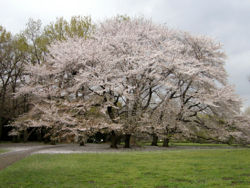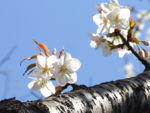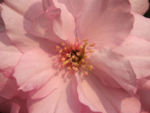Cherry blossom
| Cherry blossom |
|---|

|
| Scientific Classification |
|
| Species |
|
Cherry Blossom or Sukura is the common name for 3 separate species of ornamental Cherry trees within the genus Prunus. They are indigenous to the Himalayas and east Asia. The best known is the Japanese Cherry (Prunus serrulata).
Anatomy
The Japanese Cherry is an upright tree that is mainly vase shaped but can be found in a round shape, with spreading branches. It can grow anywhere from 15-25 feet and be as wide as 15-20 feet. The leaves grow from 2-5 inches and are simple, alternating, and a bronze to a reddish color in the fall. The flowers begin as a white color but turn pink later in the season. The bark is a beautiful red brown mahogany color.[1]
Ornamental Uses
There are two types of cherry blossoms. One type is what we are most familiar with, and that is the kind that actually produces fruit. Some people do in fact use this type for decoration as well as for eating the fruit. The other type, that is not as commonly known is the flowering cherry blossom. All that this particular tree does is produce beautiful blossoms. Many people use this tree as decoration in their yards. Some businesses will even use them as a decoration for outside of their offices. This tree blossoms in the Spring, and many people are found gazing at the beauty of this tree.[2]
Reproduction
The Japanese Cherry reproduces in multiple ways; by flower and fruit. The reproduction by flower is done just like any other normal plant. The insects are attracted to the pollen and therefore they take that pollen to the corresponding tree. The fruit is not a common way of reproducing this tree. Although it probably helps the most, most people choose to not have the cherries grow. This reasoning is chosen because the Japanese Cherry is commonly used as decoration and not many people actually farm this tree. The average lifespan of the tree is approximately 20 years.[3]
Ecology
The cherry blossom is a deciduous tree that has a moderately wide variety of soils in which is chooses to grow. It enjoys light, medium, and heavy soil types, but they must be well-drained soils. It grows best in acidic soils, but can grow in neutral and basic soils as well. The plant best prefers to grow in lots of sun; very little shade is accepted.[4]
Gallery
Related References
- Plants for a Future
- North Carolina State University
- Missouri Department of Conservation
- Shutter MomentsCherry Guide





